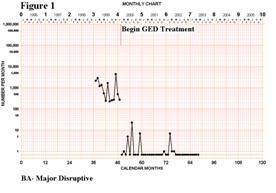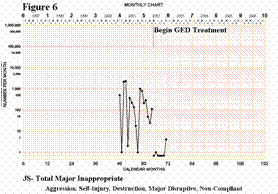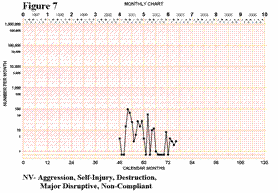
|
Use of Skin-Shock at the Judge Rotenberg Educational Center (JRC) |
Contingent Electrical Stimulation as a Treatment for Violent Disruptive Behaviors in Students with Asperger’s Disorder
Worsham, Robert W., von Heyn, Robert E., Israel, Matthew L.,Wong, Stephen A., Paisey, Timothy, and Griffin, James
Judge Rotenberg Educational Center
240 Turnpike St. Canton, MA 02021 (781) 828-2202
Based on a poster presented at Association for Behavior Analysis Conference, May 2003, San Francisco, CA
1) Conclusions
• Some students with Asperger’s Disorder can be extremely difficult to educate in normal classrooms due to the highly disruptive nature of their behaviors.
• Some develop violent disruptive behaviors that are negatively reinforced by escape from educational demands, educational structure, and control by authority figures.
• These behaviors are quite resistant to positive-reinforcement-only behavioral treatments, resulting in the necessity for a more restrictive residential educational placement
• Contingent electrical stimulation results in a rapid reduction of these behaviors, allowing for less restrictive residential and educational environments, a restraint-free medication-free status, and subsequent academic progress.
2) Introduction
The Judge Rotenberg Educational Center (JRC) is a residential special education school that emphasizes the use of behavior modification and minimizes the use of psychoactive medication.
In recent years JRC has received referrals of a growing number of students with Asperger’s Disorder. Asperger’s Disorder has also received an enormous amount of attention in recent years in the field of special education. Students with Asperger’s Disorder can be extremely difficult to educate in normal classrooms due to the highly disruptive nature of their behaviors.
They do not seem to be susceptible to social consequences, peer pressure, or authority figure sanctions which are used as attempts to discourage these behaviors. They are often the target of teasing by peers, and may develop violent behaviors as a response to this. Other factors that may lead to violent disruptive behaviors are the interruption of their inflexible ways of doing things and their noncompliance with teachers’ attempts to educate them. Their inappropriate behaviors are negatively reinforced by escape from demands and the giving-in of educational staff. The acquired strength of these negatively reinforced behaviors makes them quite resistant to positive-only behavior modification. Asperger’s Disorder students who develop violent disruptive behaviors typically end up on some type of tranquilizing and/or mood-altering medications, and it is common for them to be referred to special education residential schools.
We present data on the use of contingent electrical stimulation as a treatment for the violent and disruptive behaviors in six students admitted to JRC with Asperger’s Disorder. We also present data on one student who responded to positive-only behavioral treatment without subsequent need for aversive consequences.
3) Method
The treatment data come from seven residential students of JRC with Asperger’s Disorder who range in age from 17 through 21. In their pre-admission history they had been treated with 5, 4, 8, 7, 12, 5, and 7 different psychiatric medications, respectively, without clinically significant success. Four of the six ultimately treated with electrical stimulation were on medications at admission, and five of the six had been previously psychiatrically hospitalized. The student who was treated with positive-only procedures was on medication at admission, but had not been hospitalized. The five on medications at admission were subsequently tapered off of all psychiatric medications.
All seven students were first treated with a highly structured reward system in the form of DRO (differential reinforcement of “other” behavior) contracts and special contracts targeted at the function of their problematic behaviors. The time period for this ranged from nine weeks to 17 months. During this time major violent behaviors were managed with emergency physical restraint. For six of the seven students it was decided that the reward systems were not working sufficiently to curb their violent, dangerous, disruptive behaviors. Court authorization was obtained to treat these behaviors using the Graduated Electronic Decelerator (GED), a remote-controlled contingent electrical stimulation device developed at JRC.
4) Results
Figures 1 through 6 show a representative chart from each student treated with GED. All charts are semi-log, with totals on the y-axis and time, in the form of months or weeks, on the x-axis. The first part of the data show the results of treatment with a comprehensive positive-only behavior modification plan for the time periods of 13, 11, 2, 10, 5, and 17 months, respectively. In all six cases the subsequent treatment of violent disruptive behaviors with the GED resulted in rapid reduction of the targeted behaviors.
Figure 7 shows the slower behavioral deceleration of the combination of five problematic categories for the student who did not subsequently require treatment with GED.
5) Discussion
The results show that contingent electrical stimulation implemented via the GED device rapidly decelerated the violent disruptive behaviors of six students with Asperger’s Disorder. Sufficient behavioral progress had not been made with these students using a comprehensive system of positive reinforcement only. The deceleration of these problematic behaviors to very low levels allowed immediate subsequent advancement in educational progress, a continued medication-free restraint-free state, and the opportunity to be in less restrictive residential and educational environments. The results for the student not treated with GED shows that the positive-only systems can be successful with an Asperger’s Disorder student who has less intense forms of problematic behaviors; however, the reduction occurred more gradually over time.
 |
 |
|||
 |
|||